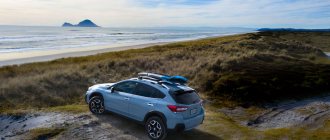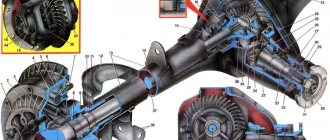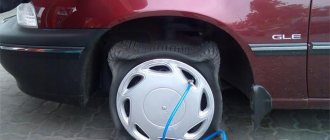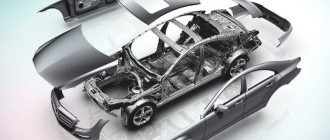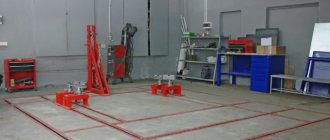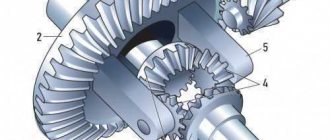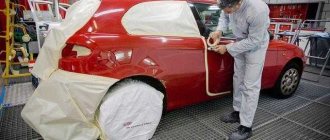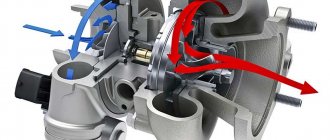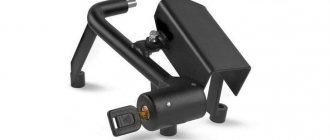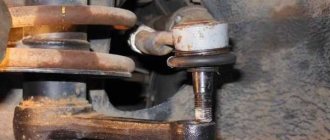One of the components of the transmission is the differential, which performs a rather important function. While driving a car, different conditions are created for the rotation of the wheels, which can affect the degree of load on the transmission units and the car’s controllability.
Rotation from the gearbox is transmitted to the main gear, which redistributes it to the wheel drives. If this transmission were carried out directly, then in any conditions the drive wheels would rotate at the same speed. On flat sections of the road, this torque distribution is what is needed. But when entering a turn, the wheels of the drive axle move along a different trajectory and travel an unequal path. Therefore, the speed of rotation of the wheels must change in accordance with driving conditions.
The problem with the correct distribution of torque between the wheels is eliminated by the differential. This unit changes the torque ratio depending on conditions, and it does this independently, without any intervention. The differential operates due to the resistance that the wheels encounter.
When moving uniformly, the wheels encounter the same resistance, so the differential distributes torque evenly. When entering a turn, the resistance on the wheel running along the inner radius increases. Increasing the force on one of the wheels causes the differential to “transfer” part of the torque to the wheel with less resistance. As a result, the wheels begin to move at different speeds - the inner one slows down, and the outer one speeds up.
What is a differential?
In short, this is an element (mechanism) directly connected to the wheel axles, the main task of which is to transmit torque to them. This transmission of torque is possible thanks to the use of the so-called “planetary mechanism”.
Another, no less important task performed by the differential is to ensure the possibility of asynchronous rotation of the drive wheels when the vehicle turns or when passing through uneven and difficult terrain.
Viscous coupling locks
This is the most common blocking. It is based on a symmetrical planetary scheme. The work is based on bevel gears interacting with each other. An important element of this design is a special sealed cavity. It contains an air-silicone mixture. The mechanism is connected to the axle shafts through disk packages.
If a car with all-wheel drive moves at some constant speed on a fairly flat surface, then a differential with such a lock transmits torque to the front and rear axles in a 50:50 ratio. If one of the packages rotates faster, then due to the increased pressure in the sealed container, the viscous coupling will begin to slow down the package. Due to this, the angular velocities will be equalized. The differential will lock.
Among the main advantages of this system are its simplicity and low cost. It is due to these factors that the mechanism has become so widespread in modern SUVs. If we talk about the disadvantages, automatic blocking is not carried out completely and there is a risk of overheating of the system if the blocking is used for a long time.
What is a differential lock?
Before we talk about this, let's look at how the classic type differential works.
And so .. A classic (standard) differential, or as it is also called an “open differential,” transfers power from the engine to the axle, which allows the wheels to rotate at different speeds while the car turns.
Since the distance each wheel must travel when turning is different (one wheel has a larger outer turning radius than the other wheel, which has a shorter inner radius), a differential solves this problem by transmitting torque on the separate axles of the two wheels through its mechanism. The end result is that the car can drive and turn normally.
Unfortunately, this particular mechanism has some disadvantages. It seeks to transfer torque where it is easiest.
Cross-country ability for a passenger car: types of differential locks and their application
Conductor, apply the brakes.
A differential is an indispensable attribute of any car that has a pair of drive wheels, between which torque from one source (engine) is mechanically distributed. The exception is karting, where the cornering technique is based on slipping of the drive wheels, and issues of reliability and durability are the last thing anyone cares about. Almost any free differential is a simple planetary mechanism that allows the right and left wheels to realize equal torque at different rotation speeds, which is essential when turning. But this is the main drawback: as soon as one of the wheels hangs out or gets on a slippery surface, the torque on it drops to almost zero, and then the opposite wheel, which is still in contact with the surface, also stops, since the specifics of the differential operation deprive it of torque too. There is a misconception that in this case all the traction is redistributed to the sliding wheel, and although in fact this is not the case, the result does not change: no grip - no movement.
How do we act if there is no one to push the car out of an ambush? We are trying to either place something under the slipping wheel, or load it in order to increase the friction force, thereby creating a torque, not only on this wheel, but also on the second one, as follows from the principle of the differential. But the same can be done with the help of brakes, which is what the electronic imitation of differential locking is based on: based on a signal from rotation speed sensors (usually the same ones that work with ABS), the wheel is “grabbed” by the brake mechanism - and the point, as they say, is hat. This method is used mainly on all-wheel drive crossovers and SUVs, but the PSA concern, for example, implemented it in the Grip Control system on front-wheel drive Peugeot 3008 and 2008. Moreover, what is of interest here is not so much the presence of an electronic simulation of locking, but rather the different operating algorithms: in the “ snow", "off-road" and "sand" the slipping wheel is braked with different intensity. And the maximum permissible speed for each mode is also different: for driving on snow, according to the French, 50 km/h is enough, in mud you can move no faster than 80 km/h, and in “sandy” mode - up to 120 km/h. After all, the tighter the locking, even if it’s electronic, the more problematic the controllability becomes (think about karting).
What does it mean?
If both wheels on an axle have the same traction and the force required to turn each wheel, an open differential will distribute torque evenly between them. However, if there is a difference in traction (for example, one wheel is on the asphalt and the other is in a hole or on ice), the differential will begin to distribute torque to the wheel that will rotate with the least effort (deliver more torque to the wheel that is caught on the road). ice or into a hole).
Eventually, the wheel left on the pavement will stop receiving torque and stop, while the other will absorb all the torque and spin at an increased angular speed.
All this greatly affects the maneuverability and controllability of the car, and it will be much more difficult for you to get out of a hole or walk on ice.
Blockings: what they are, why they are good and what they are fraught with
At the dawn of the automobile industry, engineers realized that a solid axle for a pair of wheels was harmful. The car drives in a straight line not only rarely, but almost never. Therefore, each tire goes its own way. Rapid tire wear and the car's reluctance to turn forced us to look for a solution. We came up with it. The axle was divided in two, into axle shafts, and a differential was placed between them. Now the wheels began to spin equally on a straight line, but at different speeds in turns. But the coverage is not always uniform. Let's say there is a stone under one wheel and loose sand under the other. Accordingly, it is easier for one wheel to spin. It's the differential that turns it. And the one for whom it is more difficult does not want to. The effect of one wheel slipping appeared. And even the drive on all four wheels did not eliminate the problem - one wheel in front and behind was slipping. Now the task is to eliminate slippage. That's why blocking was invented.
SO THAT THE WHEELS DO NOT SLIP If we consider an all-wheel drive car, then it needs three differentials: one that distributes torque between the axles (interaxle) and two between wheels on the same axis (interaxle). But for a real SUV, with a 4x4 wheel arrangement, all of them must be lockable.
Most modern SUVs are equipped with traction control systems that reduce the effect of one wheel slipping. They operate on the same principle as ABS, only in reverse. Each wheel has a sensor that shows its rotation speed. The computer reads the readings of these sensors, and if one of the wheels starts to rotate too quickly - that is, slippage occurs - it commands the brake system to slow down this wheel. Some systems also reduce the supply of mixture to the engine cylinders - they choke the engine. In most cases, these traction control systems are sufficient to prevent excessive wheel slippage. Sometimes they work so effectively that you are amazed. Of course, with frequent off-road use, such systems noticeably increase the wear of brake pads and discs, but this, as you will understand from the article, is not the worst of evils. If the car is not equipped with a traction control system or its actions seem insufficient to the owner, you can additionally equip the car with differential locks and achieve a much greater effect.
BIG DIFFERENCE But blocking is different from blocking. Some turn off the differential completely, others only partially. Accordingly, in the first case, if at least one wheel is on solid ground, the car will move. In the second, this will happen until the difference in the adhesion of the wheels to the surface exceeds a certain limit. Therefore, blocking can be divided into complete and partial. Moreover, complete locks can be activated either manually or automatically, but partial ones work only independently. Most can be installed in place of a conventional differential or replace one type of lock with another. And since each type has its own advantages and disadvantages, such a modification makes sense.
LOCK COMPLETELY Complete locking does not allow a difference in the speed of rotation of the axle shafts and, accordingly, the wheels. Off-road, where slipping may occur, this is useful: the likelihood that the car will stop moving, losing traction, is reduced. But on hard surfaces, complete blocking of the axle shafts will lead to increased wear not only of the tires, but also (at high speeds) of the transmission elements. And most importantly, a car with a locked differential does not want to turn. Therefore, the “lock” should only operate when necessary. This can be achieved, for example, by setting the manual drive to on-off. This type of locking is called forced, is controlled by the driver using a lever or button and requires constant monitoring of its condition. From time to time, owners of cars with this type of lock forget to turn it off in time, which sometimes leads to serious consequences. In addition, it should be borne in mind that the load on a completely locked transmission increases greatly. Indeed, during quiet movement, the force from the engine is distributed approximately equally across two or even four wheels. What if only one wheel has traction? Then the load on one axle shaft increases fourfold. The part may not be ready for such stress. For example, you can install a full set of such locks on a Niva. They are. But at the very first serious test, when the entire load falls on one axle shaft, it may simply not withstand it. It's not designed for this. And an exciting adventure will turn into a trip on a tow truck. You can, of course, replace the axle shafts with reinforced ones, but then the drive parts may not withstand it. And so on. A simple improvement will turn into a complete redesign of the car. Therefore, before you put complete blocks, consider whether the game is worth the candle.
Source
What is a differential lock?
A locking differential allows both wheels to move at the same speed, so if one wheel loses traction, both wheels will continue to move regardless of differences in resistance. In other words, if one wheel is on the pavement and the other is in a hole or on a slippery surface such as mud, ice or others, the locking differential will send the same power to both wheels, allowing the wheel on the ice or hole to move faster and keep the car from moving. immerse. A locking differential can be added to the front or rear axle, and can be added to both axles.
Blocking purpose
The peculiarity of the functioning of the differential has one negative side - the less resistance the wheel encounters, the more rotation the unit will transmit to it. This results in the fact that the wheel that hits a slippery surface or is suspended receives 100% torque, while the second wheel of the axle, standing on a hard surface, remains without rotation. As a result, the car becomes immobilized. Because of the differential, overcoming even minor off-road conditions can turn into a problem; the car will simply end up in the mud and that’s all.
You should not drive a passenger car off-road.
If ordinary passenger cars are not designed for off-road driving, then differentials on SUVs do not allow them to fully realize their capabilities. The negative quality of the differential is eliminated by blocking it. But not all car enthusiasts know how differential locking works and what it actually is.
The lock is a special mechanism added to the differential design and ensures forced distribution of torque across the wheels in a certain ratio. That is, the blocking eliminates the possibility of rotation being applied to only one wheel of the drive axle. As a result, even if one of the wheels hits a slippery surface, torque will be applied to the second one, so the car will retain the ability to move.
Designers have developed a variety of types of differential locks. Despite the structural differences, they all perform the same task - they maintain the distribution of torque along the axes in a given ratio.
In general, existing locks are divided into three types:
- Tough
- Partial
- Electronic
The first two types include many options that differ in design, but use the same operating principle.
Differential lock types
Depending on the degree, differential locking can be complete or partial:
- Full locking implies a rigid connection of the differential elements, in which the torque can be transmitted entirely to the wheel with better traction
- Partial differential locking is characterized by a limited amount of transmitted force from the differential parts and a corresponding increase in torque to the wheel with better traction
There are different types of locks, but they can usually be divided into several large groups:
- differentials that lock tightly (100%)
- automatic differential lock
- limited slip differentials - LSD
Types of locks
You can block the operation of the mechanism by directly connecting its body to the loaded axle shaft or by limiting the possibility of rotation of the satellites. There are the following types of blocking:
- Full: The transmitted torque reaches 100%. The differential parts are rigidly connected to each other and, as a result, it cannot perform its functions.
- Partial: Torque in a certain ratio is forcibly distributed through the differential and limits the operation of its elements.
Depending on the degree of driver participation, the differential lock can be carried out manually or automatically:
- Forced blocking is performed by the driver as needed (manual blocking). A cam differential is used for this.
- The limited-slip differential automatically sets operating limits (automatic locking). The requirement for blocking and its degree are determined by the difference in torque on the axle shafts of the drive wheels or their angular speeds. Some types of such systems use a differential lock sensor.
100% complete blocking
With this type of locking, the differential actually ceases to perform its functions and becomes a simple coupling that firmly connects the axles and shafts and transmits torque to them at the same angular speed. To completely lock the differential, it is enough to either block the ability to rotate the axles, or connect the differential cup to one of the axles. This type of locking is carried out using an electric, pneumatic or hydraulic mechanism and is manually controlled by the driver.
However, complete locking is not recommended because not only is the car's engine heavily loaded, but the transmission, gearbox and tires, which wear out very quickly, also suffer from heavy loads.
Hard lock
The main feature of the rigid type of locking is that, once engaged, it distributes the torque equally between the axles. That is, the drive axle begins to work as if there was no differential in its design at all.
The simplest design of a complete lock is to create a rigid connection between the differential housing mounted on the driven gear of the main gear and one of the axle shafts. As a result of this connection, the differential loses the ability to distribute rotation and transmit it to only one wheel.
The simplest design of a complete lock is reduced to fitting an additional clutch with a control mechanism onto the splines of the axle shaft. This clutch, as well as the differential housing, has teeth that engage these elements.
To lock, you just need to engage the clutch with the body and the axle shaft becomes rigidly connected to the main gear.
Mechanical interlock
Full locking is used on both cross-wheel and center differentials of SUVs and has exclusively forced manual engagement. At the same time, this mechanism is often not used on the front axle so as not to affect the car’s handling.
The operating principle of the full locking mechanisms is identical for all options; the differences are only in the design. But their drives can be different:
- mechanical;
- hydraulic;
- pneumatic;
- electric.
In this case, all types of drives perform one task - they engage the coupling with the housing.
The mechanical type of drive is presented in the form of a system of rods and levers, the hydraulic one is represented by two cylinders (main and working) connected to each other by a pipeline, the pneumatic type is represented by a pneumatic cylinder with a working chamber, and the electric one is by an electric motor.
The advantage of hard locking is to ensure high cross-country ability of the car, since under any conditions the wheels always move at the same speed.
But there are also disadvantages:
- Increased load on the transmission;
- Inability to drive on paved roads;
- High speeds of movement are not allowed;
- Manual control.
Despite this, many fans of full-fledged SUVs prefer this type of locking.
Limited Slip Differentials - LSD
This type of differential is essentially a convenient compromise between an open differential and a full differential lock, as it allows it to be used only when necessary. The biggest advantage of LSD is that when the car is moving on smooth roads or highways, it acts as an “open” differential, and when driving on rough terrain, the differential changes from “open” to locking, which ensures trouble-free driving. turns and climbs or descents on uneven, pothole-filled and muddy roads. Switching from an open differential to a limited slip differential is extremely quick and easy and is done using a button on the car's dashboard.
LSD has three main types:
- disk mechanism
- worm gear
- viscous bond
With disk lock
Friction is created between the discs. One friction disc has a rigid connection to the differential cup, and the other to the shaft.
Worm lock
The principle of its operation is very simple: increasing the torque of one wheel leads to partial blocking and transmission of torque to the other wheel. (Worm lock is also called Torque Sensing).
Viscous bond
It consists of a set of closely spaced drilled discs housed in a sealed housing filled with silicone fluid, which are connected by a differential cup and drive shaft. When the angular velocities are equal, the differential operates normally, but when the rotation speed of the shaft increases, the discs located on it increase their speed and harden the silicone located in the housing. Because there is a risk of overheating, this type of locking is rarely used.
Types of Locking Devices
The locking device of a node depends on its type and the mechanism used. Various functions are limited and determine the possibility of their use in center or cross-axle differentials.
Cam locking device
Forced locking occurs manually through a claw clutch. The clutch completely blocks the mechanism and rigidly connects its body with the loaded axle shaft. The cam differential is driven by the following types of actuators:
- mechanical;
- hydraulic;
- pneumatic;
- electric.
They are activated by a lever mechanism or a special button on the instrument panel (for electric drive).
Due to its versatility, the cam differential is used in interaxle and cross-wheel mechanisms.
Self-locking differential
A self-locking (automatic) differential device uses the principle of increasing friction forces when the load conditions on the axle shafts of the drive wheels change. Hence another name - “limited slip differential” or LSD (Limited Slip Differential).
The limited slip differential has four main options depending on the method of increasing friction:
- disk;
- worm;
- viscous coupling;
- electronic lock.
Disk
The limited slip differential, which uses a disc clutch, uses the principle of automatic locking when the angular speeds of the axle shafts change: the greater their difference, the higher the degree of torque redistribution.
When using this type of LSD, friction occurs between the discs. One friction pack has a rigid connection with the differential cup, the others with the axle shafts.
The friction packs rotate at the same speed when the drive wheels also rotate at the same speed. When the angular velocity changes, the disks of the accelerating axle shaft transmit part of the torque to the shaft of the other axle shaft (partial blocking) due to an increase in the friction force with the friction package of the housing (cup).
The compression ratio in a disc differential can be constant (spring driven) or variable (hydraulically controlled).
Worm
Worm-drive gears and axle shafts are often used to create an LSD that locks as a result of torque differences.
This worm-drive LSD system is known as Torque Sensing, or Torsen for short. The principle of operation of a worm gear is extremely simple: an increase in torque on one axle shaft leads to partial blocking and its transmission to the other axle shaft. In this case, no additional systems or assemblies are required; the worm unit is initially self-locking due to the properties of the drive, in which other gears cannot drive the worm gear. Worm drives are used in wheel and center differentials of various types of machines.
Viscous coupling
A viscous coupling consists of a series of closely spaced perforated discs that are sealed with silicone fluid and connected to a cup and drive shaft.
At the same angular velocities, the device operates in normal mode. Its blocking occurs when the shaft speed increases: the discs on it increase the speed and, mixing the silicone, force it to harden. The cup discs receive and transmit torque to the other shaft, increasing its traction force.
LSD, the locking function of which is performed by a viscous coupling, has large overall dimensions and is used in center differentials. The viscous clutch can also be used as a differential in an all-wheel drive vehicle and performs its full functions.
However, it has one serious drawback: it can overheat and is intermittently incompatible with the ABS system. This has led to the fact that viscous couplings are used extremely rarely in modern cars.
Electronic lock
The limited slip differential, which uses an electronic locking system, responds to changes in the angular speed of the drive wheels.
The differential is controlled by software. As wheel speed increases, the pressure in the brake system increases and its speed decreases. This increases traction and transfers torque to the other wheel.
Thus, the differential is not equipped with additional elements and is not locked, that is, in fact, it is not an LSD. Redistribution of torque and equalization of angular velocities occurs under the action of a braking system controlled by a traction control system.
Automatic differential lock
Unlike manual interlocking, automatic interlocking is controlled differentially by software. When the rotation speed of one wheel increases, pressure is created in the brake system and its speed decreases. In this case, the traction force becomes higher, and the torque is transferred to the other wheel.
Redistribution of torque and equalization of angular velocities is carried out under the influence of the braking system. It is software controlled by the traction control system, the automatic locking differentials do not have additional locking components and are not an LSD.
Mitsubishi Pajero Sport
Mitsubishi Pajero Sport. Mitsubishi Photos
The third generation of this model has all the attributes of a serious SUV, including the presence of a frame, a rear beam and a rear cross-axle differential lock. It’s not for nothing that the “Japanese” performs well in difficult conditions, even when hung diagonally.
Under the hood of the car there are 2.4 and 3.0 liter engines. The first is a turbodiesel and with a power of 180 hp. considered the optimal choice for lovers of off-road adventures. The more powerful 210-horsepower gasoline engine is coupled only with an automatic transmission, which is more suitable for a more comfortable ride not in extreme conditions.
Can every car have a locked differential?
Differential locks are usually used for sports cars or SUVs. Particularly in the case of SUVs, locking differentials are already installed during vehicle assembly. Although a differential lock is recommended especially for SUVs, it is possible that a differential lock can be performed on another type of vehicle. Vehicles that do not have a differential lock at the factory can be modified and upgraded.
Chevrolet Niva
Four wheels are slipping - neither locking nor lowering will help.
You'll have to look for a tug or dig yourself out. Four wheels are slipping - neither locking nor lowering will help. You'll have to look for a tug or dig yourself out.
TO THE HARM...
When driving in a straight line, all wheels travel the same length and rotate at the same speed. Accordingly, the blocking does not manifest itself in any way here. Another thing is driving in a turn, where all the wheels follow their own trajectories, go through different paths and must rotate at different angular speeds. The sharper the turn, the more significant the difference. And here a rigid connection only harms. Equalizing the angular speeds of the wheels leads to their slipping or slipping and, as a consequence, to the loss of trajectory stability.
Just for fun, you can verify this with a visual example: on an asphalt site, turn the wheels of the Niva all the way, turn on neutral in the transmission and transfer case, and try to push the car with your hands until it makes a full circle. It might be hard for one person, but for two it’s easy. Now lock the center differential. Even if you combine the efforts of several people, you will not be able to make even a quarter of a circle.
...AND FOR THE BENEFIT
Now let's talk about cross-country ability, which largely depends on the amount of torque being realized. It is limited by the weight on the drive wheels and their grip on the road. (An engine in first low gear is usually capable of producing much more torque!)
Problems here can arise in two cases. The first is that the wheels have different grip on the road. The second is a significant redistribution of weight (for example, when driving uphill) or loss of contact with the road due to significant unevenness.
In this situation, differentials do a disservice - the realized torque will be determined by the most “useless” wheel, up to zero torque on the one hanging in the air. Then, in order for the car to move, the center differential must be locked.
Conclusion: blocking is only necessary on uneven surfaces, slippery inclines, or such irregularities that can cause the car to hang diagonally.
How it works?
If you also want to lock the differential, you should contact a service center that offers similar services. This is necessary because only there they can tell you whether your vehicle's specifications are suitable for a differential upgrade or not. If possible, our specialists will offer you compatible components that can replace the classic “open” locking differential.
Generations of Torsen differential
The Torsen self-locking differential has three generations:
- T-1 is the first generation of self-locking device. In it, satellites and gears of the driving axle shafts act as worm pairs. The satellites of the axle shafts are connected by spur gearing. The axes of the satellites are perpendicular to the semi-axes. The first generation Thorsen cross-axle differential allows the car's wheels to rotate at different speeds. When a wheel slips, the mechanism tries to transfer a significant part of the car’s engine power to another axle shaft, after which the worm pair of this axle shaft wedges. Along with this, the friction force that appears in the worm gear due to the difference in torque values on the wheels blocks the differential. The first generation of Torsen differential is the most powerful of all designs in its class.
- T-2 is the second generation of the device. The main differences from the first generation: the axes of the satellites here are located along the semi-axes; the satellites themselves are located in special pockets of the differential housing; The gears of the paired satellites involved in blocking the mechanism during wedging are helical.
- T-3 is the third generation of differential. Has a planetary design. The third generation of Thorsen is used mainly as a center differential on vehicles with all-wheel drive. The mechanism has compact dimensions due to the fact that the drive gear and the axes of the satellites are parallel in the design.
